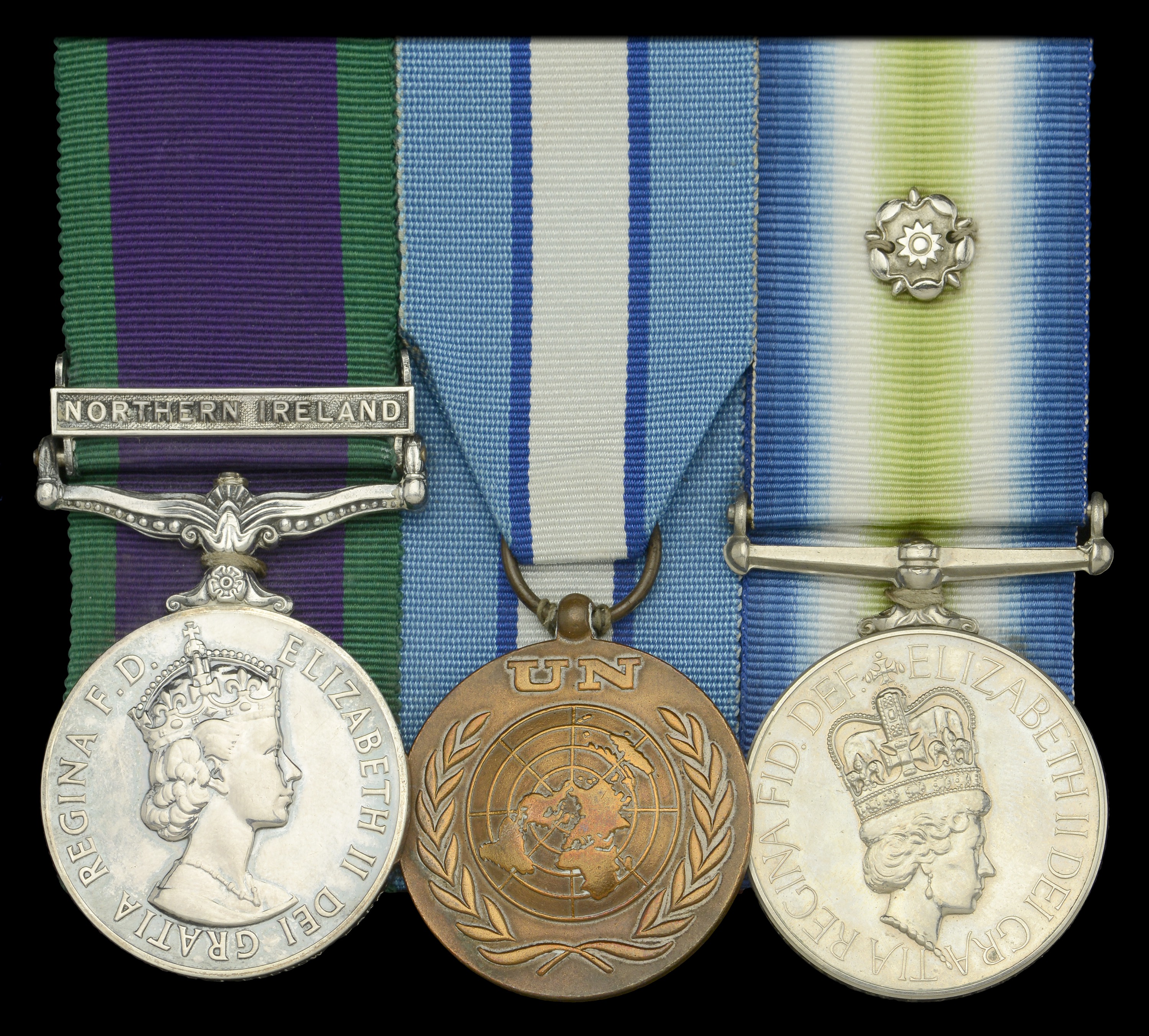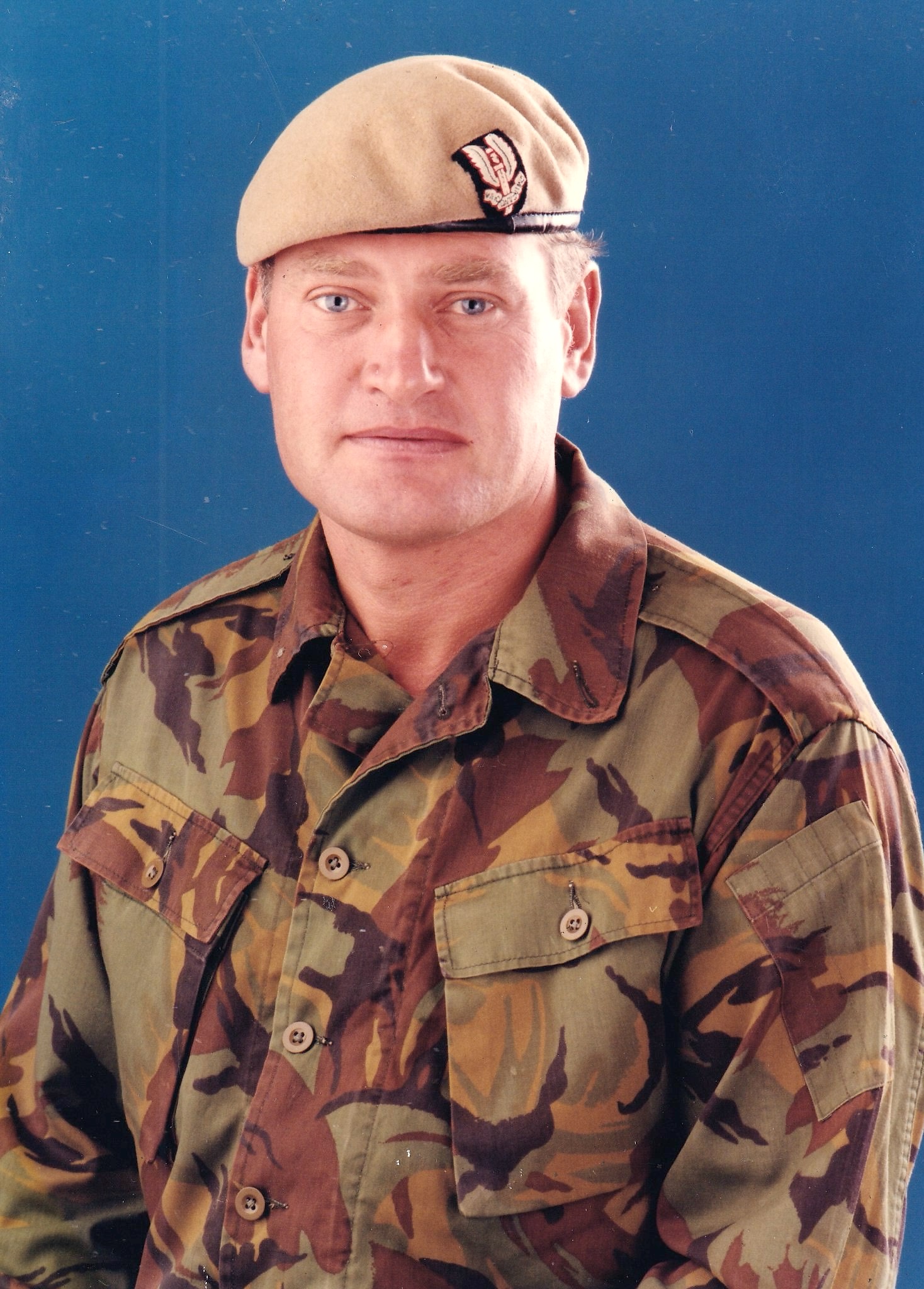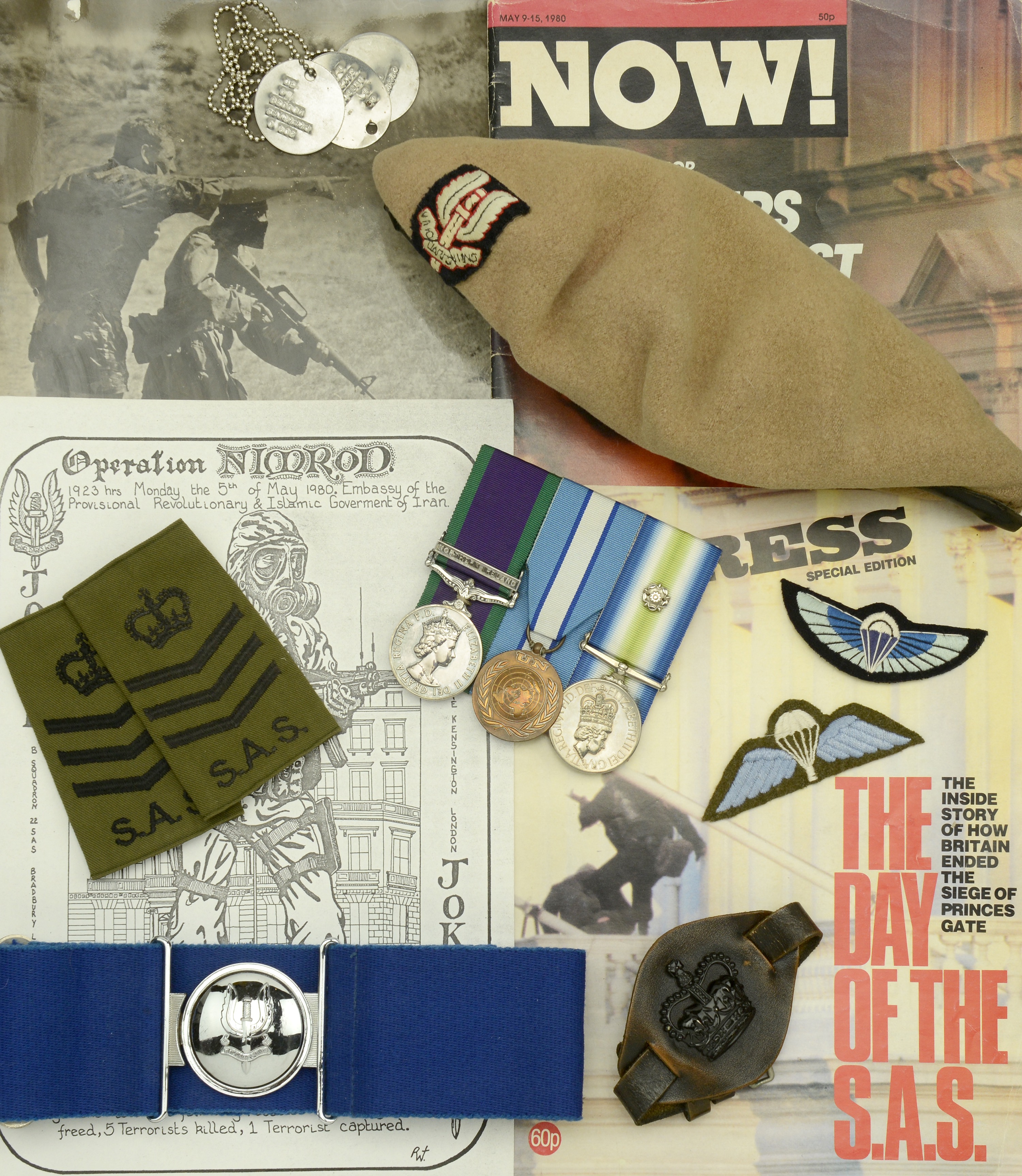350
The 'Operation Nimrod' campaign group of three awarded to Acting Warrant Officer Class I D....
Bids do not include VAT, buyer’s premium or delivery.
By confirming your bid, you agree that you have read and accepted the-saleroom.com and the auctioneer's terms and conditions. Confirming your bid is a legally binding obligation to purchase and pay for the lot should your bid be successful.
Choose one of the quick bid options below:
Bids do not include VAT, buyer’s premium or delivery.
By confirming your bid, you agree that you have read and accepted the-saleroom.com and the auctioneer's terms and conditions. Confirming your bid is a legally binding obligation to purchase and pay for the lot should your bid be successful.
General Service 1962-2007, 1 clasp, Northern Ireland (24153439 Pte, D. J. Beddow Para.); U.N. Medal, unnamed as issued,on UNFICYP riband; South Atlantic 1982, with rosette (24153439 Sgt D J Beddow Para (SAS)) mounted court-style as worn, about extremely fine (3) £8,000-£12,000
---
Importation Duty
This lot is subject to importation duty of 5% on the hammer price unless exported outside the UK
---
---
David John Beddow was born in Lichfield, Staffordshire, on 6 July 1953 and enlisted into the British Army at Wolverhampton on 16 August 1968, aged 15. ‘Like many young men of that era, I was searching for discipline, purpose, and challenge: the Army gave me all three. I joined as a junior soldier in the Royal Regiment of Fusiliers and began my military career at the Infantry Junior Leaders Battalion in Oswestry, Shropshire. The early years were formative. At the Infantry Junior Leaders Battalion I developed the foundational skills of leadership and soldiering. In 1970, I completed my first parachute jumps at the Joint Services Parachute Centre, Netheravon. Around the same time, I competed in and won the Junior Welsh 3000 event with two teammates, setting a record time in the process. Weeks before passing out, I transferred to the Parachute Regiment, a decision that would define my career. After passing the rigourous “P” Company selection, I was posted to the 3rd Battalion (3 PARA) on 16 December 1970.
Service with 1 PARA in Northern Ireland and Selection and Service with 22 S.A.S.
My initial tour with 3 PARA was both rewarding and humbling. Promoted to Lance Corporal, I attended the Section Commanders' Course at the Parachute Regiment Battle School in Brecon and then later transferred to 1 PARA, then operating in Northern Ireland. Though difficult at the time, this proved to be a decisive moment in my career. I joined 1 PARA during Operation Motorman in Belfast – a pivotal deployment during The Troubles. This was my true initiation into operational soldiering, and I found myself where I felt most effective: at the sharp end. Upon return to the UK, I was promoted to Corporal. 1 PARA was then slated for a three-year tour in Germany, but I requested a posting to the Parachute Regiment Depot, where I served as an instructor on the recruit wing from 1973 to 1976. Though honoured by the responsibility, I remained restless. The desire for greater challenge and purpose led me to volunteer for Special Air Service (S.A.S.) selection in August 1976.
On passing S.A.S. selection I was posted to “B” Squadron, 7 Troop (Air). I underwent HALO training at R.A.F. Brize Norton and qualified as an advanced patrol signaller and patrol medic. From that point onward, my life and soldiering took on new dimensions – clandestine, high-risk operations became the norm.
April 1980: Operation Nimrod, the Iranian Embassy Siege
When the siege was initiated by armed terrorists, I was conducting Methods of Entry (MoE) training south of London. That night, we deployed to a secure holding area next to 16 Princes Gate, London. I was assigned to Sierra One – the assault team designated to breach the fourth floor via a skylight on the roof. My role was to breach the entry point and then enter with the assault team. Using a sledgehammer, I cleared the skylight going into the bathroom, clearing rooms and descending toward the hostage location. If the teams below had not entered by that time, we were to assume their mission and maintain momentum. The operation was a well publicised success. The 19 hostages were secured and the terrorists were neutralised, 5 being killed, and 1 being captured.’
Falklands War and Deployment to the South Atlantic
‘In 1982, Argentina invaded the Falkland Islands. As part of “B” Squadron, we were the reserve element based in Hereford while two squadron's deployed south with the task force. Our task was to prepare for contingency operations. One such mission, codenamed Operation Mikado, involved a high-risk plan to neutralise Argentine aircraft at Río Grande, Tierra del Fuego. The concept was bold: a HALO insertion to recon a commercial airstrip, followed by Hercules-borne assault teams deploying vehicles and firepower directly onto the airfield. I was part of the six-man reconnaissance team from Air Troop briefed to jump north of the objective, assess the runway’s viability using a cone prodder, and, if cleared, guide in the main force. The mission was cancelled hours before deployment due to intelligence leaks and new imagery showing the strip’s active use by the Argentine Air Force.
Alternate plans were developed for a direct assault – understood by all to be a one-way mission. We trained for low-level static line insertions from 400 feet, no reserves, full operational loads, including incendiary devices and multi-barrel rocket launchers. Targets included aircraft, fuel supplies, and command facilities. We were then to evade west toward the Chilean border, 80 kilometres away. The R.A.F. ultimately withdrew air support, citing unacceptable risk to aircraft and crew.
Following the cancellation of Operation Mikado, we remained on standby. Then came tragic news: a Sea King helicopter transporting members of the Regiment had ditched in the South Atlantic during a cross-decking manoeuvre. Twenty lives were lost that day, all of them friends. It was a hard blow, but it galvanised our resolve. We were going south.
The plan was ambitious. Two R.A.F. C-130 Hercules aircraft would insert our squadron via static line water jump outside the Falklands exclusion zone. Every item – weapons, ammunition, and personal kit – was palletised for air drop. We wore dry suits to protect against the frigid Atlantic waters. As a touch of dark humour, some of 7 Troop jumped wearing red clown noses, a nod to the absurdity of war and our refusal to lose ourselves to it. 7 Troop boarded the first aircraft alongside Squadron HQ. Our Hercules had been modified with a large internal fuel bladder and air-to-air refuelling capability. However, our initial refuelling attempt failed - the cone from the refueller collapsed mid-air. The pilot requested we return to Ascension, but our OC insisted we wait for the tanker intended for the second aircraft. It was dispatched to our location while the second Hercules was sent back to Ascension.
I watched the refuelling from the cockpit as the spare pilot took control, placing the Hercules in a deep dive in order to match the tanker's speed. The flight engineer gave constant updates. When the refuelling was complete, the pilot was physically lifted from his seat, drenched in sweat, utterly spent. But we had fuel, and we were inbound. We exited over the South Atlantic. It was daylight when we jumped and I was unaware that the pallet containing my GPMG, AR-15, and personal equipment had suffered a parachute failure and hit the water hard. My pack frame was bent nearly in half. My laser rangefinder was destroyed. I only had my 9mm pistol, magazines, belt kit so had to rearm quickly once recovered by the Royal Navy.
Shortly after, we were informed of the Argentine surrender. The war, for us, was effectively over. Our frustration was palpable. We had trained, prepared, lost friends, but now would play no direct part in the final phase...
General Service 1962-2007, 1 clasp, Northern Ireland (24153439 Pte, D. J. Beddow Para.); U.N. Medal, unnamed as issued,on UNFICYP riband; South Atlantic 1982, with rosette (24153439 Sgt D J Beddow Para (SAS)) mounted court-style as worn, about extremely fine (3) £8,000-£12,000
---
Importation Duty
This lot is subject to importation duty of 5% on the hammer price unless exported outside the UK
---
---
David John Beddow was born in Lichfield, Staffordshire, on 6 July 1953 and enlisted into the British Army at Wolverhampton on 16 August 1968, aged 15. ‘Like many young men of that era, I was searching for discipline, purpose, and challenge: the Army gave me all three. I joined as a junior soldier in the Royal Regiment of Fusiliers and began my military career at the Infantry Junior Leaders Battalion in Oswestry, Shropshire. The early years were formative. At the Infantry Junior Leaders Battalion I developed the foundational skills of leadership and soldiering. In 1970, I completed my first parachute jumps at the Joint Services Parachute Centre, Netheravon. Around the same time, I competed in and won the Junior Welsh 3000 event with two teammates, setting a record time in the process. Weeks before passing out, I transferred to the Parachute Regiment, a decision that would define my career. After passing the rigourous “P” Company selection, I was posted to the 3rd Battalion (3 PARA) on 16 December 1970.
Service with 1 PARA in Northern Ireland and Selection and Service with 22 S.A.S.
My initial tour with 3 PARA was both rewarding and humbling. Promoted to Lance Corporal, I attended the Section Commanders' Course at the Parachute Regiment Battle School in Brecon and then later transferred to 1 PARA, then operating in Northern Ireland. Though difficult at the time, this proved to be a decisive moment in my career. I joined 1 PARA during Operation Motorman in Belfast – a pivotal deployment during The Troubles. This was my true initiation into operational soldiering, and I found myself where I felt most effective: at the sharp end. Upon return to the UK, I was promoted to Corporal. 1 PARA was then slated for a three-year tour in Germany, but I requested a posting to the Parachute Regiment Depot, where I served as an instructor on the recruit wing from 1973 to 1976. Though honoured by the responsibility, I remained restless. The desire for greater challenge and purpose led me to volunteer for Special Air Service (S.A.S.) selection in August 1976.
On passing S.A.S. selection I was posted to “B” Squadron, 7 Troop (Air). I underwent HALO training at R.A.F. Brize Norton and qualified as an advanced patrol signaller and patrol medic. From that point onward, my life and soldiering took on new dimensions – clandestine, high-risk operations became the norm.
April 1980: Operation Nimrod, the Iranian Embassy Siege
When the siege was initiated by armed terrorists, I was conducting Methods of Entry (MoE) training south of London. That night, we deployed to a secure holding area next to 16 Princes Gate, London. I was assigned to Sierra One – the assault team designated to breach the fourth floor via a skylight on the roof. My role was to breach the entry point and then enter with the assault team. Using a sledgehammer, I cleared the skylight going into the bathroom, clearing rooms and descending toward the hostage location. If the teams below had not entered by that time, we were to assume their mission and maintain momentum. The operation was a well publicised success. The 19 hostages were secured and the terrorists were neutralised, 5 being killed, and 1 being captured.’
Falklands War and Deployment to the South Atlantic
‘In 1982, Argentina invaded the Falkland Islands. As part of “B” Squadron, we were the reserve element based in Hereford while two squadron's deployed south with the task force. Our task was to prepare for contingency operations. One such mission, codenamed Operation Mikado, involved a high-risk plan to neutralise Argentine aircraft at Río Grande, Tierra del Fuego. The concept was bold: a HALO insertion to recon a commercial airstrip, followed by Hercules-borne assault teams deploying vehicles and firepower directly onto the airfield. I was part of the six-man reconnaissance team from Air Troop briefed to jump north of the objective, assess the runway’s viability using a cone prodder, and, if cleared, guide in the main force. The mission was cancelled hours before deployment due to intelligence leaks and new imagery showing the strip’s active use by the Argentine Air Force.
Alternate plans were developed for a direct assault – understood by all to be a one-way mission. We trained for low-level static line insertions from 400 feet, no reserves, full operational loads, including incendiary devices and multi-barrel rocket launchers. Targets included aircraft, fuel supplies, and command facilities. We were then to evade west toward the Chilean border, 80 kilometres away. The R.A.F. ultimately withdrew air support, citing unacceptable risk to aircraft and crew.
Following the cancellation of Operation Mikado, we remained on standby. Then came tragic news: a Sea King helicopter transporting members of the Regiment had ditched in the South Atlantic during a cross-decking manoeuvre. Twenty lives were lost that day, all of them friends. It was a hard blow, but it galvanised our resolve. We were going south.
The plan was ambitious. Two R.A.F. C-130 Hercules aircraft would insert our squadron via static line water jump outside the Falklands exclusion zone. Every item – weapons, ammunition, and personal kit – was palletised for air drop. We wore dry suits to protect against the frigid Atlantic waters. As a touch of dark humour, some of 7 Troop jumped wearing red clown noses, a nod to the absurdity of war and our refusal to lose ourselves to it. 7 Troop boarded the first aircraft alongside Squadron HQ. Our Hercules had been modified with a large internal fuel bladder and air-to-air refuelling capability. However, our initial refuelling attempt failed - the cone from the refueller collapsed mid-air. The pilot requested we return to Ascension, but our OC insisted we wait for the tanker intended for the second aircraft. It was dispatched to our location while the second Hercules was sent back to Ascension.
I watched the refuelling from the cockpit as the spare pilot took control, placing the Hercules in a deep dive in order to match the tanker's speed. The flight engineer gave constant updates. When the refuelling was complete, the pilot was physically lifted from his seat, drenched in sweat, utterly spent. But we had fuel, and we were inbound. We exited over the South Atlantic. It was daylight when we jumped and I was unaware that the pallet containing my GPMG, AR-15, and personal equipment had suffered a parachute failure and hit the water hard. My pack frame was bent nearly in half. My laser rangefinder was destroyed. I only had my 9mm pistol, magazines, belt kit so had to rearm quickly once recovered by the Royal Navy.
Shortly after, we were informed of the Argentine surrender. The war, for us, was effectively over. Our frustration was palpable. We had trained, prepared, lost friends, but now would play no direct part in the final phase...
Orders, Decorations, Medals and Militaria
Sale Date(s)
Venue Address
General delivery information available from the auctioneer
If you are successful in purchasing lot/s being auctioned by us and opt for the item/s to be sent to you, we will use the following methods of shipment:
Within the UK
If you live within the UK, items will be despatched using Royal Mail Special Delivery. This service provides parcel tracking (via the Royal Mail website) and next weekday delivery (betwen 9am and 1pm). Items delivered within the UK are covered by our insurance company. Heavy and bulky lots will be sent by courier, in discussion with the client.
Outside of the UK
If the item/s being sent are worth under £1000 in total they are sent using Royal Mail’s Signed For International service. This ensures the item must be signed for when it is delivered.
If the item/s being sent are valued at over £1000 in total they will be sent using FedEx. This service allows next day delivery to customers in many parts of the US and parcels are fully trackable using the FedEx website.
Shipping Exceptions
Certain lots such as those containing glass or sharp implements, etc., may not be suitable for in-house shipping within or outside of the UK. Please contact Noonans with any queries.
Important Information
Auctioneer's Buyers Premium: 24% (+VAT)
There is an additional charge of 4.95% (+VAT/sales tax)

















